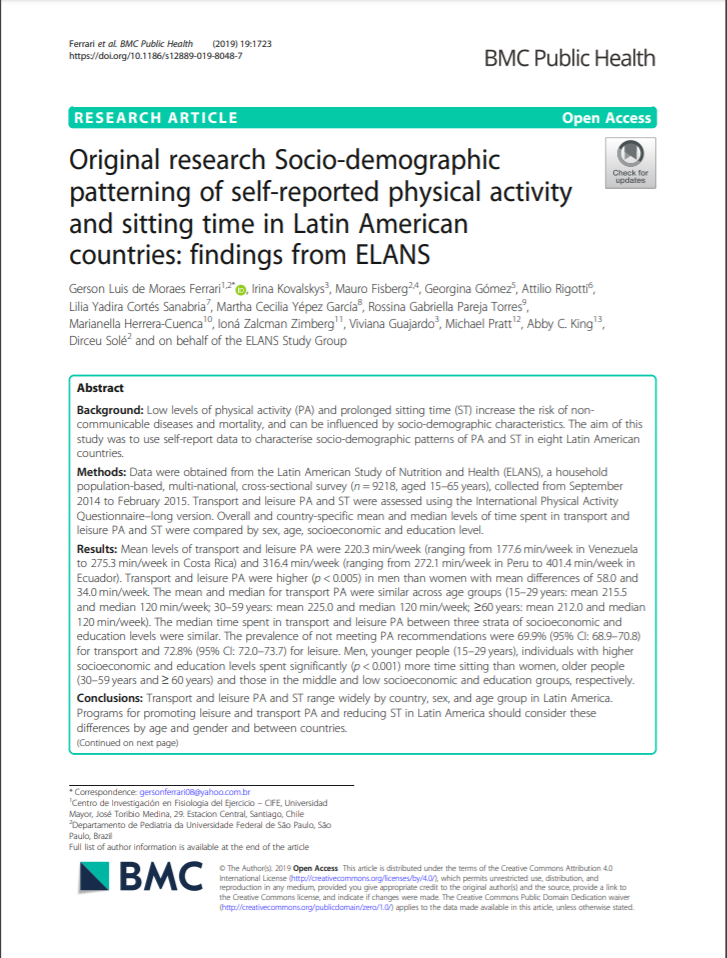Original research Socio-demographic patterning of self-reported physical activity and sitting time in Latin American countries: findings from ELANS

Fecha
2019Autor
de Moraes Ferrari, Gerson Luis [Univ Mayor, CIFE]
Kovalskys, Irina; Fisberg, Mauro; Gómez, Georgina; Rigotti, Attilio; Cortés Sanabria, Lilia Yadira; Yepez Garcia, Martha Cecilia; Pareja Torres, Rossina Gabriella; Herrera-Cuenca, Marianella; Zimberg, Iona Zalcman; Guajardo, Viviana; Pratt, Michael; King, Abby C.; Sole, Dirceu
Ubicación geográfica
Notas
HERRAMIENTAS
Acceda a títulos restringidos
¿Cómo descargar?Resumen
Background: Low levels of physical activity (PA) and prolonged sitting time (ST) increase the risk of non-communicable diseases and mortality, and can be influenced by socio-demographic characteristics. The aim of this study was to use self-report data to characterise socio-demographic patterns of PA and ST in eight Latin American countries. Methods: Data were obtained from the Latin American Study of Nutrition and Health (ELANS), a household population-based, multi-national, cross-sectional survey (n = 9218, aged 15-65 years), collected from September 2014 to February 2015. Transport and leisure PA and ST were assessed using the International Physical Activity Questionnaire-long version. Overall and country-specific mean and median levels of time spent in transport and leisure PA and ST were compared by sex, age, socioeconomic and education level. Results: Mean levels of transport and leisure PA were 220.3 min/week (ranging from 177.6 min/week in Venezuela to 275.3 min/week in Costa Rica) and 316.4 min/week (ranging from 272.1 min/week in Peru to 401.4 min/week in Ecuador). Transport and leisure PA were higher (p < 0.005) in men than women with mean differences of 58.0 and 34.0 min/week. The mean and median for transport PA were similar across age groups (15-29 years: mean 215.5 and median 120 min/week; 30-59 years: mean 225.0 and median 120 min/week; >= 60 years: mean 212.0 and median 120 min/week). The median time spent in transport and leisure PA between three strata of socioeconomic and education levels were similar. The prevalence of not meeting PA recommendations were 69.9% (95% CI: 68.9-70.8) for transport and 72.8% (95% CI: 72.0-73.7) for leisure. Men, younger people (15-29 years), individuals with higher socioeconomic and education levels spent significantly (p < 0.001) more time sitting than women, older people (30-59 years and >= 60 years) and those in the middle and low socioeconomic and education groups, respectively. Conclusions: Transport and leisure PA and ST range widely by country, sex, and age group in Latin America. Programs for promoting leisure and transport PA and reducing ST in Latin America should consider these differences by age and gender and between countries.
Coleccion/es a la/s que pertenece:
Si usted es autor(a) de este documento y NO desea que su publicación tenga acceso público en este repositorio, por favor complete el formulario aquí.